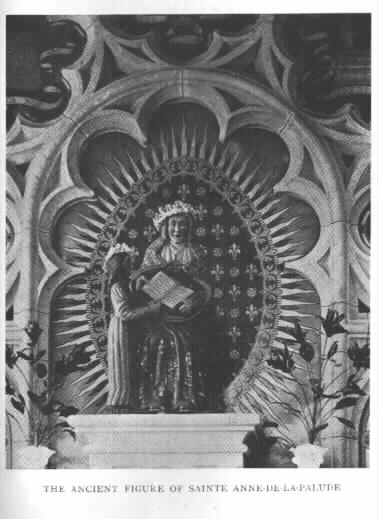
This image is facing page 254 in Anatole Le Braz. 1907.
The Land of Pardons. London: Methuen & Co.
According to tradition, the mother of the Blessed Virgin Mary was St. Anne. As the apocryphal Gospel of the Birth of Mary (which can be found in pages 17-24 of The Lost Books of the Bible (New York: Bell Publishing Company, 1974)) tells us:
Her [Mary's] father's name was Joachim, and her mother's Anna. The family of her father was of Galilee and the city of Nazareth. The family of her mother was of Bethlehem (1:2).
This tradition is very old, and among her name's variants are Anne among the Bretons (see the references following) and Hanna among the Ethiopians (see Sir E. A. Wallis Budge (ed.)'s 1933 work One Hundred and Ten Miracles of Our Lady Mary (London: Humphrey Milford, Publisher to the Oxford University Press), page xliv). Really very little is known for sure about her, although there are numerous legends regarding her. Her feast is celebrated in the Roman Catholic Church on 26 July, the article regarding her life being taken from:
Butler's Lives of the Saints with Reflections. 1894. Compiled from Lives of the Saints, originally by Fr. Alban Butler. New York: Benziger Brothers, printers to the Holy Apostolic See, 1894.
Among the Bretons it is believed that St. Anne was Queen of Brittany, now the westernmost Provence of France. It is said that her husband the King's greatest fear was of a child, and upon Anne's pregnancy she was thrown out of the royal household. Walking along the Breton shoreline St. Anne reportedly met an Angel who brought her to the Holy Land aboard a white ship. Online, you may read legends of the Saint's life in Brittany. This is taken from:
Johnson, William Branch. 1927. Folktales of Brittany. London: Methuen & Co.

In Brittany are at least two statues believed to have miraculous origins. The first of these, pictured above and preserved at Ste-Anne-de-la-Palue (or Palude) is said to have been pulled from the sea by fishermen. Reportedly it was decided to take the statue to the nearest church, but upon reaching a spot where St. Anne had requested Our Saviour assure that a church be built in her honour the statue became so heavy that it was no longer possible to move it, despite the efforts of all the men in the district. This was taken to be a sign, and a church was constructed to St. Anne. One of Brittany's great pardons -- celebrations seeking the intercessions of and thanking the saints -- now centres at this site. This pardon is discussed in:
Le Braz, Anatole. 1907. The Land of Pardons. London: Methuen & Co.
In the summer of 1623, following a Apparition of St. Anne, Ste-Anne-d'Auray dug up a statue of her which had been hidden during the day of vandalism and constructed a church to her on the spot. The Church of St. Anne in Ste-Anne-d'Auray still preserves the statue. Information about both of these miraculous statues can be read online. This selection is taken from:
Johnson, William Branch. 1927. Folktales of Brittany. London: Methuen & Co.
According to Joan Carroll Cruz (cited below), contrary to the legends that St. Anne disappeared body and soul, the remains of St. Anne are widely dispersed. Among these are a relic kept at Ste-Anne-d'Auray, as well as a portion of the wrist of St. Anne in Canada.

In 1658 a group of Breton fishermen, following a near shipwreck from which they were miraculously saved, landed at the "Beautiful Meadow" now known as Ste-Anne-de-Beaupré in Quebec, Canada. In thanksgiving for their deliverance, the men vowed to build a church in the honour of the patron of Brittany, a church which they immediately began work on and which has now grown into a great basilica. About twenty miles from the City of Quebec, the shrine to St. Anne now consists of the Basilica, the Memorial Chapel (a reconstruction of the original church), a miraculous fountain, a wax museum of the shrine's history, life-size Stations of the Cross, and a replica of the Scala Santa, the stairs taken from Pilate's palace and up which Christ walked to be condemned.
Along the rear wall of the Basilica are ex-votos deposited there by pilgrims, largely in thanks for miraculous healings. These include a line of crutches left by cripples reportedly healed through St. Anne's intercession. The earliest healing at the shrine is said to have been that of one Louis Guimont, a crippled man who insisted on carrying stones for the construction of the first church despite his affliction and who was cured before the other workers' eyes.
Among the tresures preserved at Beaupré perhaps the most important are the shrine's seven relics of St. Anne. The largest of these is a portion of the wrist of St. Anne which was presented to the shrine by Pope Leo XIII in 1892 when it was translated from the Basilica of St. Paul Outside the Wall in Rome. The wristbone is now on St. Anne's altar behind the yellow onyx column supporting the miraculous statue of the Saint.
This information is available on pages 135-136, 153-154 of:
Cruz, Joan Carroll. 1984. Relics. Huntington, Indiana: Our Sunday Visitor.
This shrine is also discussed online in the article:
Sadlier, Anna T. 1882, October. "St. Anne de Beaupré." The Catholic World, vol. 36, iss. 211, pgs. 83-91.
The picture above is a pamphlet cover depicting the Basilica of St. Anne, obtained at the Shrine circa 1965.